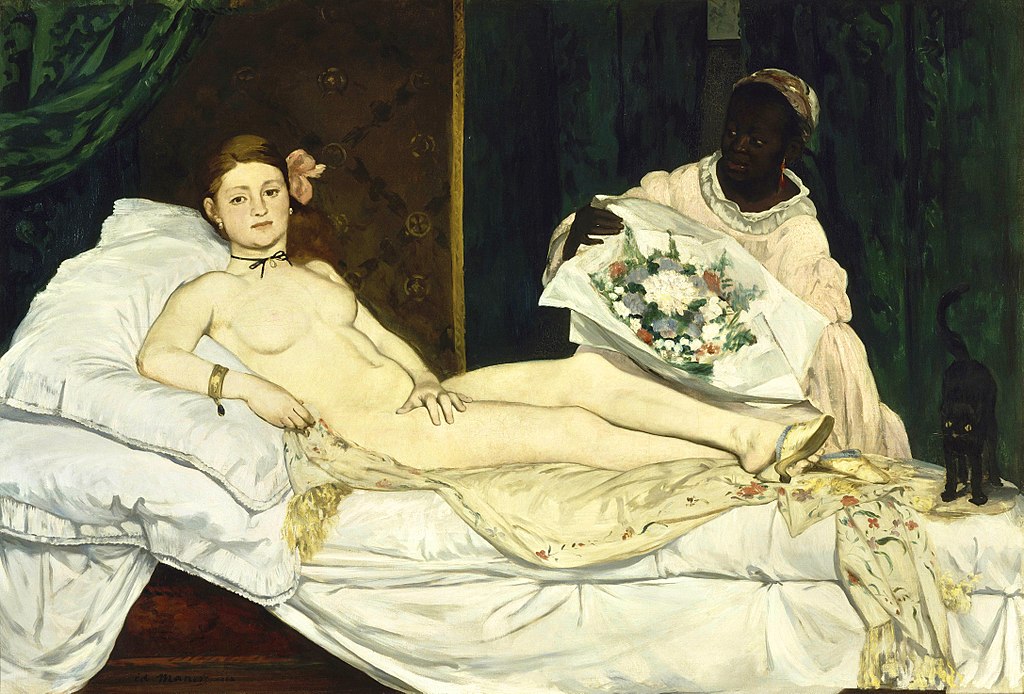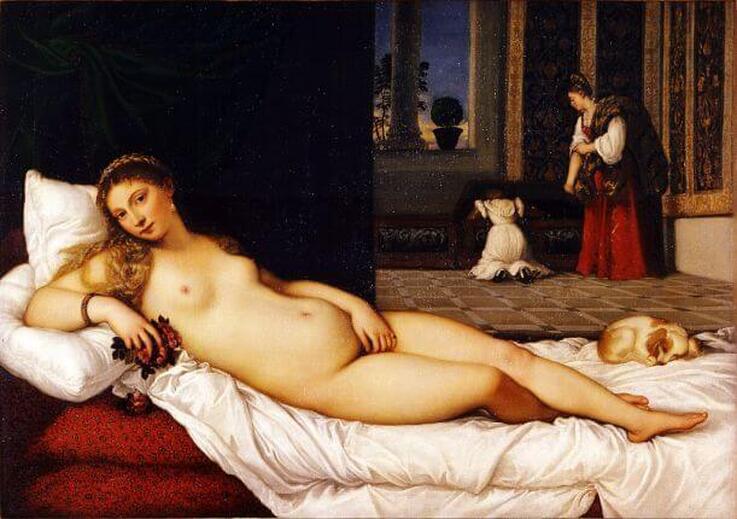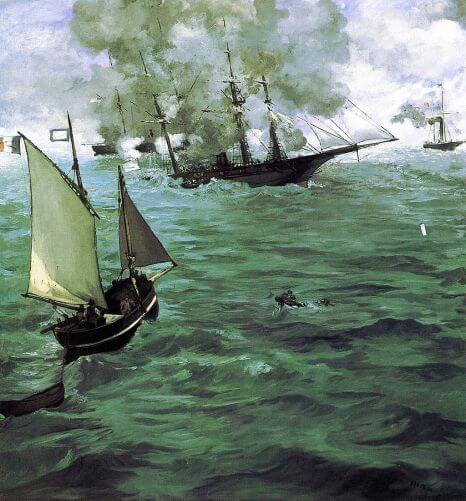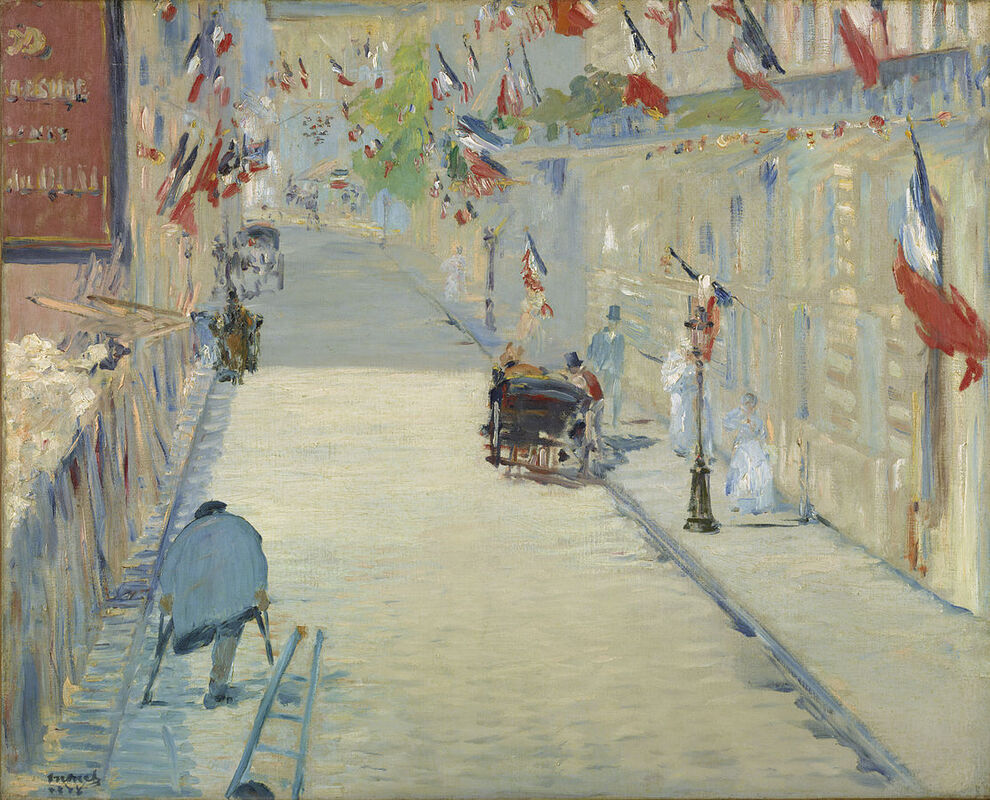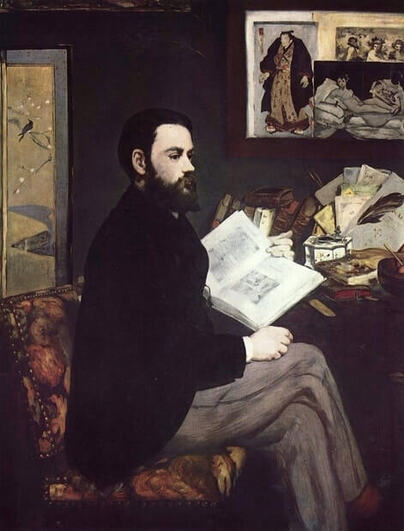|
Where? Room 14 on the Ground floor of the Musée d’Orsay
When? 1863 What do you see? A Parisian prostitute, Olympia, lies down on her bed in her apartment. She rests atop a floral cloth, staring directly at the viewer as her servant presents her with a bouquet (perhaps a gift from an admirer or patron). Olympia’s left hand is firmly placed over her private area. She is pale, and her features are not idealized as was typically done by other artists at this time. Instead, Manet painted her realistically. Olympia’s body has dark outlines and broad color that lacks shading. She appears flat and stands in stark contrast to the dark brown and green background behind her. At her feet is a startled black cat with its tail raised. Backstory: Victorine Meurent served as the model for Olympia. She was a painter herself and served as a model for various artists. Manet liked her as a model because of her petite stature and red hair. Laure served as the model for the maid, and she posed for several other paintings of Manet. Édouard Manet got his inspiration for Olympia from the Venus of Urbino, the iconic Renaissance painting by Titian in the Uffizi Museum. Titian’s painting is a classic example of the female nude as a manifestation of ideal beauty. His reclining nude, like most, was shrouded in perfection and mythology. It was not inherently sexual. In his painting, Manet reduced the female nude to a much more realistic form. There is no beauty or goddess to admire; the viewer is confronted with Olympia’s sexuality as well as the reality of prostitution in Paris. And unlike the demure and reserved reclining nudes of the past, Manet’s modernized version features a woman who addresses the viewer and holds a firm posture.
Controversy: The painting caused quite an uproar when it was displayed in the Paris Salon in 1865. The French public was not ready to receive such a bold painting that deviated so strongly from what they were used to. Over seventy critics condemned the work for a variety of reasons and political cartoons mocking Olympia as ugly surfaced in newspapers and magazines.
The realistic style of this painting was not appreciated. Moreover, to show a sex worker as so bold and independent was very unconventional during the time. The idea that Olympia could live so comfortably (with flowers and jewelry) shook critics to the core. In addition, the painting breaks tradition by showing an imperfect female nude who stands in contrast to the flawless depictions of Venus from the past. Who is Olympia? In 1860s France, “Olympia” was an alias commonly used by prostitutes or courtesans. She is not of lower status as we would expect. Instead, she is shown to be of a higher class, adorned with jewelry and resting on a floral blanket with a servant at her side. Who is Manet? Édouard Manet was born in 1832 in Paris where he died 51 years later. He was a Parisian realist painter who studied in the studio of Thomas Couture for six years. Afterward, however, Manet decided against attending the official art school of the French Academy, the École des Beaux-Arts. Early on in his career, he befriended the poet Charles Baudelaire whose work featured urban outsiders such as prostitutes and street entertainers. Baudelaire’s writing inspired Manet to continue painting unusual characters alongside his other works that featured better-known figures such as musicians and writers. Manet also had a love for the sea and occasionally liked to capture this in this works, such as the Battle of the Kearsarge and the Alabama in the Philadelphia Museum of Art. While most of Manet’s works can be classified under Realism, he is also one of the masterminds behind the development of Impressionism. The Rue Mosnier with Flags in the Getty Museum is a good example of his Impressionist ideas.
Fun fact: In 1867, Manet held a solo exhibition during the World’s Fair in Paris. Once again, Olympia was on display. When the painting received criticisms once again, writer Emile Zola defended it with a pamphlet that praised Manet’s bold style and technique. He asked viewers to overlook the subject matter and appreciate Manet’s avant-garde approach to art. As thanks, Manet produced the Portrait of Emile Zola. It features Zola in his study, reading some of his own works. In the upper right, Manet added a miniature print of Olympia to Zola’s wall.
Written by Sabrina Tian
References:
0 Comments
Leave a Reply. |
Categories
All
|
- Home
- Blog
-
Museums
- Alte Pinakothek
- Art Institute of Chicago
- Baltimore Museum of Art
- Barber Institute of Fine Arts
- Bargello
- Barnes Foundation
- British Museum
- Church of Sant’Anastasia
- Cleveland Museum of Art
- Courtauld Institute of Art
- Detroit Institute of Arts
- Frans Hals Museum
- Galleria Borghese
- Gallerie dell'Accademia
- Getty Museum
- Guggenheim
- Hermitage Museum
- Kunsthistorisches Museum
- Kunstmuseum Basel
- Legion of Honor Museum
- Louvre
- Mauritshuis
- Metropolitan Museum of Art
- Musee d’Orsay
- Museum of Fine Arts in Boston
- Museum of Modern Art
- National Gallery in London
- National Gallery of Art
- National Museum in Poznań
- Norton Simon Museum
- Ny Carlsberg Glyptotek
- Palace of Versailles
- Palazzo Pitti
- Palazzo Vecchio
- Petit Palais
- Philadelphia Museum of Art
- Prado
- Pushkin Museum
- Ravenna Art Museum
- Rijksmuseum
- San Diego Museum of Art
- Santa Maria delle Grazie
- St. Peter's Basilica
- Städel Museum
- Statens Museum for Kunst
- Tate Britain
- Tate Modern
- Timken Museum of Art
- Uffizi
- Vatican Museums
- Wallace Collection
-
Artists
- Altdorfer
- Anguissola
- Berlin Painter
- Bosch
- Botticelli
- Boucher
- Bronzino
- Bruegel the Elder
- Brunelleschi
- Cabanel
- Caillebotte
- Canova
- Caravaggio
- Carpeaux
- Cezanne
- Cimabue
- David
- Degas
- Delacroix
- De Maria
- Donatello
- El Greco
- Fontana
- Fra Angelico
- Fragonard
- Gauguin
- Gentileschi
- Gericault
- Gonzalez-Torres
- Goya
- Hals
- Hogarth
- Hokusai
- Ingres
- Leonardo da Vinci
- Lippi, Filippo
- Longhi, Barbara
- Lorrain
- Makovsky
- Manet
- Massys
- Matisse
- Merian
- Michelangelo
- Mochi
- Modigliani
- Monet
- Panini
- Parmigianino
- Perugino
- Picasso
- Pisanello
- Raphael
- Rembrandt
- Renoir
- Reynolds
- Rivera
- Rodin
- Rubens
- Scultori
- Seurat
- Steen
- Tintoretto
- Titian
- Toulouse-Lautrec
- Turner
- Uccello
- Van der Weyden
- Van Dyck
- Van Eyck
- Van Gogh
- Van Hemessen
- Vasari
- Velazquez
- Vermeer
- Veronese
- Vigée Le Brun
-
Locations
- Books
- About Us

